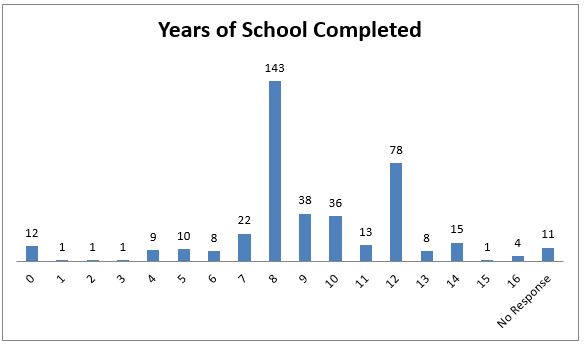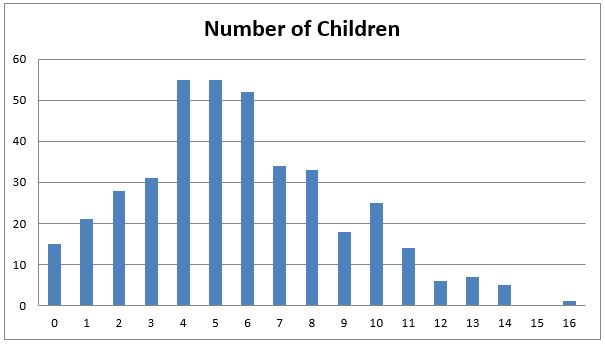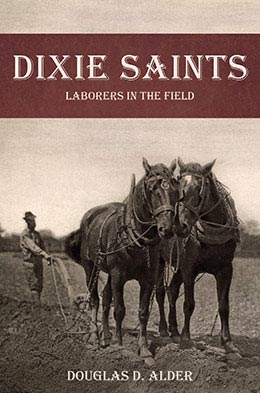Appendix: Statistics of the Voices of Remembrance Interviews
Douglas D. Alder, “Appendix: Statistics of the Voices of Remembrance Interviews,” in Dixie Saints: Laborers in the Field, ed. Douglas D. Alder (Provo, UT: Religious Studies Center; Salt Lake City: Deseret Book, 2017), 291-356.
Observations about Interviewees
First, 425 people were interviewed between 1968 and 1970 by Fielding H. Harris. At that time, they were living in Washington County, Utah, or nearby. Of these interviews, 17 were either not completed or were inaudible, leaving 408 completed ones. The chart allows readers to find the names, birth dates, locations, number of siblings, years they attended school, number of children, number of marriages, health difficulties (if any), involvement level in the LDS Church, work skills, and other items.

Second, these people were born between 1870 and 1933. Out of the 408 people interviewed, 11 were born between 1870 and 1879, 83 between 1880 and 1889, 157 between 1890 and 1899, 110 between 1900 and 1909, 36 between 1910 and 1919, and 11 between 1920 and 1933. Therefore, these stories come from people who were born mostly between 1880 and 1910. Some who were interviewed were elderly, even in their late nineties. They and even their younger contemporaries might have had some memory limitations which impacted the interview. All of the interviews were dependent on memory. Memory is usually enlightening but can color the comments, even to the point of eulogy or blame. Readers of these interviews have to act as critical readers.
Third, all of these people were survivors. They perpetuated the village system and the values promoted by their parents and grandparents. They made it through the flu epidemic of 1918–19. They survived in the desert. They knew how to produce food, build modest homes and villages, irrigate, herd, barter, work timber, and wander to find seasonal and domestic jobs when they were not involved in agriculture. Manual labor was the way of life for both men and women. They mastered the use of herbal medicine and the creation of fabric. However, many of their children and even parents did not survive.
Fourth, they were often born in families of many children, mainly 5 to 13 siblings. The following group listed only siblings, thus excluding themselves from the total. All total, 382 of them listed 2,808 siblings, 24 did not list any siblings at all, 8 listed 1, 23 listed 2, 19 listed 3, 22 listed 4, 30 listed 5, 22 listed 6, 30 listed 7, 36 listed 8, 32 listed 9, 42 listed 10, 31 listed 11, 28 listed 12, 16 listed 13, 3 listed 14, 1 listed 15, 4 listed 16, 0 listed 17, 2 listed 18, and 28 listed 0.[1]

Some of those interviewed also listed siblings who died: 21 reported that 1 of their siblings died, 22 reported that 2 died, 9 reported that 3 died, 5 reported that 4 died, 5 reported that 5 died, and 1 reported that 6 died.
Fifth, they lived in villages. Most of the villages were established before 1900, and a few—Veyo, Central, Ivins, Hurricane, La Verkin, and Enterprise—were established by 1910. Several villages had been abandoned, such as Hebron, Bloomington, Price, Atkinville, Heberville, and Duncan’s Retreat. Those people interviewed mainly reported that they loved their childhood. They always had enough to eat, largely because families had a large garden and produced ample food. They loved being with their numerous siblings and the many friends in neighboring homes that also had many children. By living in a village, their lives were different from many people in other western states who lived on homesteads, a long distance from neighbors. Adults from the villages often reported on the vitality of community life, celebrations, water companies, church life, and neighborhood cooperation.
Sixth, the majority of these people were the offspring of the original Mormon settlers in southern Utah, southern Nevada, and northern Arizona—the area named the Mojave Desert and the Colorado Plateau, an arid climate mostly at about 2,500 feet elevation. The original settlers, the interviewees’ parents or grandparents, began arriving in 1852, and then the big immigration started in 1861–62. Harmony was the first village, followed by Washington and Toquerville, then Santa Clara, Pine Valley, Gunlock, Hebron, and Hamblin on the west side. Virgin, Grafton, Rockville, Springdale, and Shunesburg were established on the upper Virgin River approaching Zion Canyon. Some temporary villages also existed there, like Duncan’s Retreat. In Long Valley, north of Springdale and Mount Carmel on the Virgin River, the towns of Orderville and Glendale were founded. St. George was established in December 1861 and January 1862. Bloomington, Price, Atkinville, and Heberville existed for a while south of St. George but were later abandoned. Leeds, Harrisburg, and Pintura were established north of St. George on the route to Harmony. Pinto was west of Pintura, high in the Pine Valley Mountains. Bunkerville, Mesquite, and Las Vegas were early Mormon settlements in Nevada, south of the Utah boundary. Pioche, Nevada, was a mining town on the western border of Utah where some Mormons went, but Caliente, Panaca, Logandale, Glendale, Modena, and Beaver Dam were founded by Mormon settlers in Nevada and Arizona, near the western border of Utah. Fredonia and Mount Trumbull were in northern Arizona. Several of the people interviewed lived in the counties north of the Mojave Desert in Iron and Garfield Counties, some even farther north. A few were from Panguitch, north of Cedar City, as well as Cedar City and Beaver. About 20 of the interviewees were born in other states in the US and Canada but later moved to southern Utah. At least a dozen interviewees were born in Europe before immigrating to southern Utah from Norway, England, Germany, and Switzerland. About 25 came to southern Utah from villages in Mexico that Mormons had settled some twenty years before the Mexican Revolution of 1910–12.

Seventh, almost all of the interviewees attended school, mainly in the villages where one teacher taught all grades, usually spending fifteen minutes per day with each grade while the others did their assignments. Woodward School in St. George opened in 1901 and offered eight grades, and soon after, ten. Dixie Academy opened in 1911 and offered four years of high school until 1916, and then it added the first year of college; and in 1917, the academy added the second year. A high school was started in Hurricane in 1917. Until that time, those desiring to attend high school had to go to Cedar City or Beaver. A select few went to Brigham Young University in Provo, the University of Utah in Salt Lake City, or Utah State Agricultural College in Logan. Only about ten attended any of those colleges. The others attended schools in their hometowns. The chart shows how far a student progressed in the grade system: 1 through first grade; 1 through second grade; 1 through third grade; 9 through fourth grade; 10 through fifth grade; 8 through sixth grade; 22 through seventh grade; and 143 through eighth grade. Most students who completed school through the eighth grade did so in the villages. By leaving their villages, 38 students progressed through ninth grade, 36 through tenth grade, 13 through eleventh grade, and 78 graduated from high school in the twelfth grade. Many of these graduates were born in the twentieth century. Beyond this, some reported attending school after high school graduation: 8 progressed through grade 13 (freshman in college) and 15 through fourteenth grade (sophomore), which could be completed at Dixie College after 1917. And after freshman and sophomore years, 1 progressed through fifteenth grade (junior) and 4 through sixteenth grade (senior), undoubtedly at a university. Out of the remaining interviewees, 11 gave no answer, and 12 said they did not attend school at all. All total, the number reported was 411.
Eighth, all but one of the people on this list were married, and many of them were married by age 16. Most had children, but had somewhat fewer than their parents had: 21 people listed 1 child, 28 listed 2, 31 listed 3, 55 listed 4, 55 listed 5, 52 listed 6, 34 listed 7, 33 listed 8, 18 listed 9, 25 listed 10, 14 listed 11, 6 listed 12, 7 listed 13, 5 listed 14, 1 listed 16, 5 gave no report, and 15 listed 0. That is the report of 408 people. The total number of births was 2,300. In the column that listed the number of children, some parents, but not all, also noted the number who died, by putting a slash after the number of children born. The total number of children who died was 191. The death of husbands or wives before the age of 40 was not unusual. One woman reported being a widow for 35 years. Most remarried within two or three years, likely because they had many young children to raise and a farm and garden to maintain. Of those interviewed, 85 listed having more than one spouse, and most of those were the result of the death of a spouse.

Ninth, many of the interviewees faced serious health challenges, either in themselves or in their families. They reported the deaths of 116 children, and 237 of the interviewees said that they either had health challenges personally or saw them in their children or spouse. Medical doctors were seldom available in the rural villages where most of the people lived. There were two in St. George and one in Hurricane, but the people in the villages seldom had access to them. Some of those interviewed reported increased health care in the 1930s to the 1950s. A few were even able to travel north to hospitals by that time.
Tenth, the “Church,” “Mission,” and “Temple” columns give a picture of religious life in this Mormon region in the period between 1880 and 1970. This was a time before the cultural and religious diversity that is present today. Mormonism was dominant in the region. There were two small Presbyterian congregations with schools, and after 1956, a Roman Catholic church was established in St. George the Catholic church has a large congregation now. There was a Catholic congregation for a decade in Silver Reef in the 1880s. Referring again to the table, the 348 people who said “Yes” in the “Church” column were responding as Latter-day Saints. Of those, 248 went through the temple. This means that the latter group included the most committed members. It is unlikely that all of the members attended their village religious service every week. There were varying degrees of commitment. Some who lived on ranches were rarely able to travel to the nearest village for services. There were also varying levels of obedience to such commandments as the Word of Wisdom. Nonetheless, every village had an active ward with a bishop and many others serving in various callings as teachers, musicians, visiting and home teachers, and clerks. The members carried out spiritual and secular assignments, including building churches. There was a stake president with two counselors and a high council of twelve men who supervised most of the villages, traveling there frequently. From this report it is clear that most of the people considered themselves as Latter-day Saints.
During those days, the central Church leaders in Salt Lake City requested a few people to serve full-time proselyting missions, generally for two years. They had to support themselves. Sixty-nine people said that they accepted and completed such a calling. Some of them were married men who left a wife and children at home while they served away from home. The family had a garden and farm to help support them, but the children who were old enough had to work nearly full-time to support the family. Often, uncles and aunts helped. The majority of the missionaries were young men, though a few young women also served. Both groups went before they were married. They served mainly in the United States—New England, the South, California, Oregon, Wyoming, and Kansas. A few served in England and Switzerland, 1 went to Hawaii, and another to Korea. This required a strong commitment and generally had a major positive impact on their lives. Being married in the temple and attending the temple thereafter was another measure of religious commitment. Those who checked that column numbered 264. Some of them went to the temple for their initial marriage. Others went there a few years later to seal their civil marriage. Quite a few of those interviewed became active temple attendees, daily or weekly, in their senior years, often when they moved to St. George to be nearer to the temple.
Eleventh, the column listed “Other” mentions many things, including service. About a dozen served in World War I and 2 in World War II. Scores of the people served in volunteer community activities such as the Red Cross and the Daughters of Utah Pioneers. Some also volunteered as election judges, and several worked at the United States Post Office. Many men served on the canal water companies or cattlemen associations, which often took many hours of their time. Some maintained cemeteries. Others were civil servants, including four men who served terms in the Utah State Legislature. One man was in the Civilian Conservation Corps. A few women were midwives, often without pay. Others prepared bodies for burial. Several men were mayors. Many folks played in community bands. the chart does not detail all of this service, the individual interviews included in the book do.
Remember, the words of these interviews are firsthand accounts. As with many memoirs, they are both insightful and biased. These accounts are so important because little has been written about laborers, maybe because they seldom wrote memoirs or articles. Furthermore, little has been written about this middle period between the pioneering and the industrialized consumer society for which this area has become famous—tourism and retirement living in the southwest desert. Now, the region’s higher education is widespread, its medical facilities are among the nation’s best, its highways are sophisticated, and it abounds with technology. In 1910, survival was marginal. Nonetheless, the people who then lived in that area furthered the implantation of Western civilization that is thriving. Though this study is limited to the arid region of the Mojave Desert, the stories these people tell are very similar to the other 450 Mormon villages in the intermountain region. Those areas were semiarid and used the same village system. Their focus on community, family, service, and hard physical labor is very similar.
Notes
[1] This means that rather than not listing any siblings at all, this group of people confirmed that they had zero siblings. The other group, “29 did not list any siblings at all,” simply means there were no siblings on record, but it is possible that they may have had siblings.
